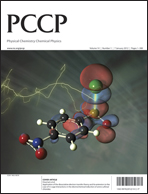Annealing approach to form a nanotube from graphdiyne ribbon: A theoretical prediction
IF 2.9
3区 化学
Q3 CHEMISTRY, PHYSICAL
引用次数: 0
Abstract
A precisely controllable heat treatment process is critical for nanofabrication. We developed a two-step method to fabricate a graphdiyne nanotube (GNT) through heat treatment in an argon environment. Initially, we placed a carbon nanotube (CNT) near a rectangular graphdiyne nanoribbon (GNR) to trigger the self-scrolling of the ribbon. Once the ribbon forms a scroll, we increased the ambient temperature to induce the formation of interlayer covalent C-C bonds within the scroll, ultimately resulting in a GNT after system annealing. The self-scrolling process of the GNR, protected by argon gas, is highly sensitive to ambient temperature. Molecular dynamics simulations show that self-scrolling can be controlled by adjusting the gas density and/or ambient temperature. In summary, a controlled heating process starting from an ultralow temperature initiates the self-scrolling of a GNR onto a CNT, followed by the generation of covalent bonds within the GNR at higher temperatures. Since the new covalent bond topology remains stable even after cooling, a stable GNT is obtained. The size of the pores on the GNT shell depends on the number of newly formed bonds. These insights will enhance the fabrication and application of GNTs as nanofilters.从石墨二乙烯带形成纳米管的退火方法:理论预测
精确可控的热处理过程对于纳米制造至关重要。我们开发了一种在氩气环境中通过热处理制造石墨二炔纳米管(GNT)的两步法。首先,我们将一根碳纳米管(CNT)放置在矩形石墨二炔纳米带(GNR)附近,以引发纳米带的自卷曲。一旦碳带形成卷轴,我们就提高环境温度,促使卷轴内形成层间共价 C-C 键,最终在系统退火后形成 GNT。在氩气的保护下,GNR 的自卷轴过程对环境温度高度敏感。分子动力学模拟显示,自卷积可通过调节气体密度和/或环境温度来控制。总之,从超低温开始的受控加热过程启动了 GNR 在 CNT 上的自卷积,随后在较高温度下在 GNR 内部生成共价键。由于新的共价键拓扑结构在冷却后仍然保持稳定,因此获得了稳定的 GNT。GNT 外壳上孔隙的大小取决于新形成键的数量。这些见解将有助于制造和应用 GNT 作为纳米过滤器。
本文章由计算机程序翻译,如有差异,请以英文原文为准。
求助全文
约1分钟内获得全文
求助全文
来源期刊

Physical Chemistry Chemical Physics
化学-物理:原子、分子和化学物理
CiteScore
5.50
自引率
9.10%
发文量
2675
审稿时长
2.0 months
期刊介绍:
Physical Chemistry Chemical Physics (PCCP) is an international journal co-owned by 19 physical chemistry and physics societies from around the world. This journal publishes original, cutting-edge research in physical chemistry, chemical physics and biophysical chemistry. To be suitable for publication in PCCP, articles must include significant innovation and/or insight into physical chemistry; this is the most important criterion that reviewers and Editors will judge against when evaluating submissions.
The journal has a broad scope and welcomes contributions spanning experiment, theory, computation and data science. Topical coverage includes spectroscopy, dynamics, kinetics, statistical mechanics, thermodynamics, electrochemistry, catalysis, surface science, quantum mechanics, quantum computing and machine learning. Interdisciplinary research areas such as polymers and soft matter, materials, nanoscience, energy, surfaces/interfaces, and biophysical chemistry are welcomed if they demonstrate significant innovation and/or insight into physical chemistry. Joined experimental/theoretical studies are particularly appreciated when complementary and based on up-to-date approaches.
 求助内容:
求助内容: 应助结果提醒方式:
应助结果提醒方式:


